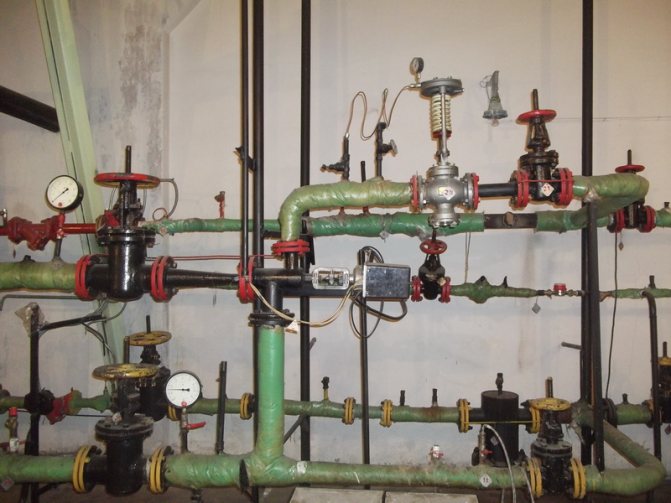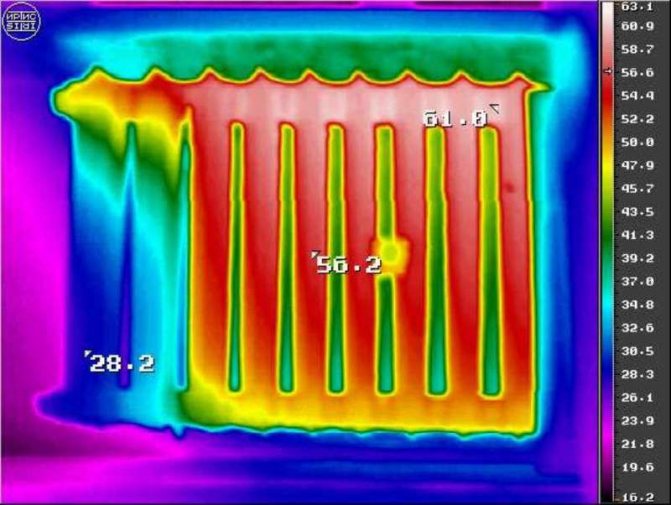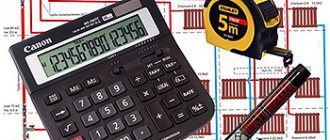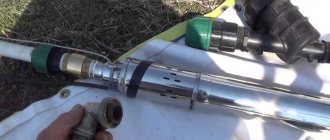General Director of the managing and operating company Ksenia Shankina answers:
The “Rules for the provision of communal services to citizens” envisage a ban on the suspension or restriction of the provision of communal services in the event that consumers fully comply with the obligations established by law.
Nevertheless, the legislation implies possible interruptions in the heating supply, and the following permissible standards are enshrined in the "Requirements for the quality of utilities". The reasons can be emergency or preventive work. In particular, the following breaks are provided:
- no more than 24 hours in total within a month;
- no more than 16 hours at a time (at an air temperature in residential premises from + 12 ° C);
- no more than 8 hours at a time (at an air temperature in residential premises from +10 to + 12 ° C);
- no more than 4 hours at a time (at an air temperature in residential premises from +8 to + 10 ° C).
Batteries are leaking - what to do?
Should the management company fix the leaks in the apartment?
Private lawyer Victoria Suvorova (Pyatigorsk) answers:
Of course, you cannot turn off the heating in winter. But here it should be noted that if this happened as a result of an emergency shutdown, that is, there was a pipe break, an accident, a flood, etc., then a temporary heating limitation for the period of emergency work and the elimination of the leak is permissible. It is not clear from the question what incident happened to you. If the neighbor changes the heating system, then this is wrong. You can file a complaint with the Criminal Code, HOA, emergency service, Teploservice, Housing Inspectorate, prosecutor's office and with a lawsuit against a neighbor for compensation for moral damage and damage caused by the lack of heating in the apartment in winter.
Flushing the heating system

Using a pump to clean the heating system
During the operation of heating, scale inevitably appears on the walls of pipes and radiators. If it is not removed in time, the efficiency of the heating system will be significantly reduced. This is due to a decrease in the working diameter of the line. In addition, the thermal conductivity index decreases - most of the thermal energy is spent on passing through the scale layer and the walls of pipes or radiators.
To avoid this, the complete instructions for starting up the heating system include a flushing procedure. It can be done in several ways, each with its own advantages and disadvantages. To increase the effectiveness of this measure, special equipment should be used - a pump with a tank for flushing liquid.
Chemical washing
The most popular type of cleaning, as it removes the overwhelming amount of scale and sludge. However, you need to be very careful in choosing the composition - some of them negatively affect the condition of plastic pipes and connectors. It is noteworthy that in some cases, the start of central heating is also carried out with their use. The purifier must contain special inhibitors, which form an additional protective layer on the inner surfaces of the mains and heating devices. It helps prevent rust.
Hydrodynamic flushing
Often, the first start-up of a heating system is done after hydrodynamic flushing. Compared to the chemical method, this method is characterized by a large mechanical effect on external elements in the system. Ordinary distilled water under high pressure flows along the entire line.All debris that may remain after installation inside the pipes will be washed away.
Hydropneumatic flushing
The technology is similar to the hydrodynamic one, but differs in a greater value of the generated pressure. It is used to start an autonomous heating system, in which there is a high probability of the presence of a formed thick layer of scale. As an additional device, you can use a pneumatic gun, with which you can accurately flush individual heating elements - batteries, boiler heat exchanger, etc.
Before starting the heating system in a private house, it is necessary to perform a pressure test. It is designed for closed pipelines with an operating pressure of up to 3 bar.
To start the heating system in winter, and in particular for flushing, you can rent the necessary equipment. The attached instructions will help you understand the principle of operation of a particular pump.
The head of the legal support department Ksenia Buslaeva answers:
Formally, the contractor providing utilities (today, in the overwhelming majority of cases, this is the management company, that is, the management company), has the right to suspend the provision of the service (in this case, the heating of an apartment building, that is, MKD), but only for scheduled or emergency repair work. The maximum allowable period for turning off heating in the MKD during the heating season is 24 hours during a month or at a time no more than 16 hours, provided that the temperature in residential premises is not lower than + 12 ° C.
In fact, the owner of the apartment, in which it is planned to repair the heating system during the heating season, applies to the Criminal Code with a request to authorize work that may entail a cessation of heat supply to all or part of the apartment building. The final decision on further actions of the Criminal Code is taken independently - either to authorize and carry out repair work, or not.
Purpose: replacement of radiators
How to reduce heating bills if the batteries are barely warm?
Preparing the heating system for winter step by step
There is no life without heating. It is very unpleasant to stay in winter without heating or on the eve of frost to understand that the house is warming up in parts or the radiators are "slightly warm". Preparing the heating system for the winter, which must be done strictly step by step, will help to avoid the problem.
Heating system preparation steps
The first step is to check the tightness of the heating circuit. For this, we fill the heating system with water. Filling is done through the drain valve, it is the lowest in the system. Bottom water filling allows air to be forced out of the system.
The system is completely filled, and the air release is controlled using air vents.
We leave the filled system for 1-2 hours. This time is enough to bypass the entire heating system and check the absence or presence of leaks in the system. We pay special attention to the connection points of heating devices, pipe connections and all kinds of threaded connections.
We pay special attention to the readings of the manometer. If you do not see leaks, but the pressure of the pressure gauge drops, then we continue to look for leaks. We mark the found leaks for elimination.
If possible, we fix the leaks immediately. If the leak is serious, then we eliminate it after draining the water and re-check the system for leaks.
After eliminating the leaks, if any, of course, we proceed to the next step of the check - pressure testing. Pressure testing is the same test of the heating system, but under pressure, 1.5 atm. We complete the pressure testing with a control start-up of the heating boiler.
Important! Depending on the type of boiler, starting up the boiler also requires some checks. The boiler check is done according to the boiler operating instructions. So for a gas boiler, you need to carefully check the gas pipeline and the inlet, gas fitting.
After starting the heating boiler, go to the next step, check the heating radiators. We go through all the radiators and feel each section of the radiator. If we find that the radiator section has not warmed up, then we reduce the temperature in the system, poison the air to eliminate air congestion and check the system again. If we find that the sections of individual radiators do not warm up well, then these radiators need to be noted and washed after draining the water.
When all checks are certified, it remains to flush the entire system under pressure with clean water.
The preparation of the heating system for winter is completed by filling the proven system with a coolant (water or antifreeze).
© Obotoplenii.ru
Konstantin Bobrov, director of the Edin.center legal service, answers:
The legislation does not prohibit turning off the heating in order to repair the heating system, since the lack of repair can lead to even more negative consequences (to the breakdown of the entire system). Therefore, it is even necessary to implement it.
However, the owner of the apartment where the work will be carried out is obliged to carry out repairs in such a way that it causes as little inconvenience as possible for the neighbors: it should be as efficient and quiet as possible, a warm day should be chosen for the work, and so on.
What to do if this citizen does not respect the interests of neighbors (for example, works in a 30-degree frost)? You can complain about him to the prosecutor's office. It is advisable to attach written explanations from other neighbors to the application. The prosecutor's office will have to bring the offender to administrative responsibility. In addition, compensation for non-pecuniary damage can be recovered from the perpetrator in court if the violation caused significant suffering. To do this, you need to prepare a substantiated statement of claim. But judicial practice shows that the amount of compensation will be small.
Underfloor heating types
Today, three types of underfloor heating are most known:
- warm water floors;
- cable floor heating;
- film infrared heating.
Warm water floors
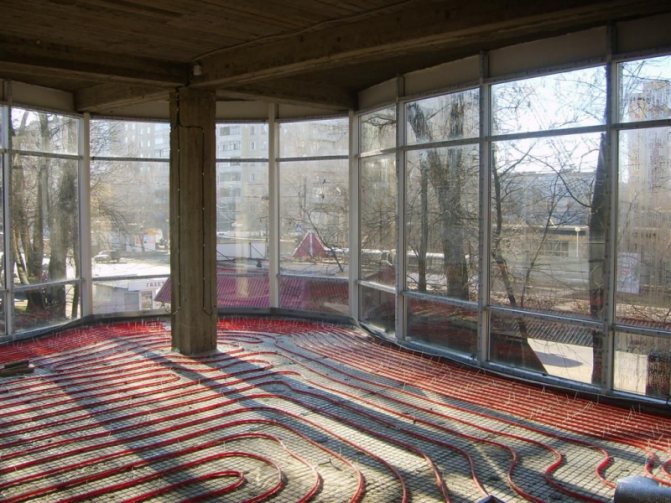

The water floors are covered with cement screed and take a long time to warm up
Water floors are a piping system connected to a gas boiler through a manifold block. The boiler "makes" the floor coverings warm by supplying hot water.
Pipes for the water system are used from cross-linked polyethylene, polyurethane, metal-plastic and copper. The most popular are XLPE pipes. Polyurethane products require the use of special welding equipment for installation.


The best quality copper pipes. At the same time, these are the most expensive pipelines.
Warm water floors are covered with cement screed. How long the flooring will warm up depends largely on the thickness of the cement screed. Pipes for underfloor heating are usually used with a diameter of 16 mm. This size, confirmed by the accumulated operating experience, is determined on the basis of heat engineering calculations.


Copper piping begins to give off heat most quickly
A certain number of heating circuits located in several rooms are heated with hot water through the collector unit.
Heating engineers recommend making the length of the 1st circuit about 70 m with a pipe diameter of 16 mm. The height of the screed is recommended to be no more than 50 mm. In this case, the thickness of the screed over the laid pipes will be about 30 mm.
Related article: Make a stove or fireplace more attractive with heat-resistant varnish


The floors will reach the required temperature no earlier than after half a day.
How much does the warm floor warm up when you first turn it on under such conditions?
Practice shows that the heating time of the warm floor at the first start-up can last from 12 hours to one and a half days.
For this, the water leaving the boiler is brought to a temperature of 90 ° C.
After the floor warms up, the initial temperature of the coolant is lowered to 70 ° C.
If the floor heats up for a long time, then the reason must be sought in improper installation and connection of heating circuits or the equipment was turned on with a "wet" screed.
Cable floor heating
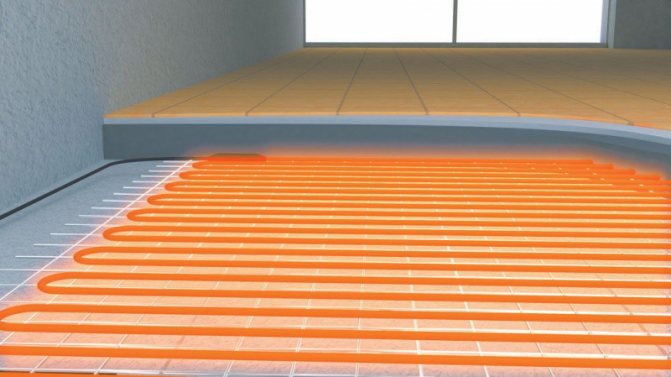

Cable floors warm up quickly and cool down slowly
The cable is laid in the form of a spiral and a snake. The spiral shape is used in small areas (up to 20 m2). On large-sized bases, the cable is fixed in the form of a snake.
The electric heating element will quickly heat up and begin to give off heat to the floor body. A screed thickness of 70 mm or more will significantly increase the inertness of the concrete. In this case, the floor will take longer to heat up, the more slowly it will cool down. At the same time, electricity consumption will increase significantly.
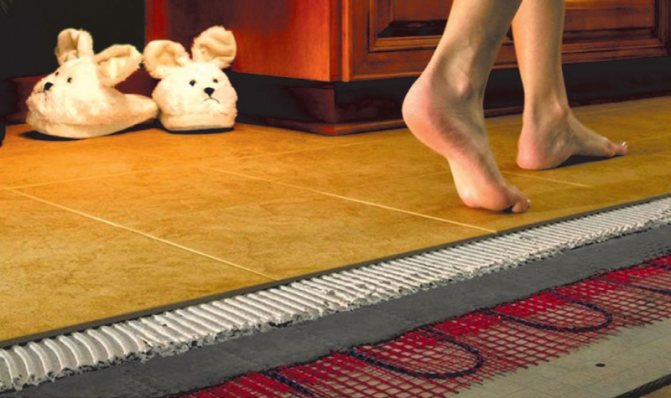

For the first heating, it takes from 6 to 8 hours
How much warm floors warm up when the cable is first turned on depends largely on the power of the wire.
With proper installation of electrical heating and compliance with building codes when laying the screed, the time for the first heating of the base of the room can be from 6 to 8 hours.
When a cable covered with a bitumen sealant is laid under a ceramic tile layer, the heating time of the floor covering is significantly reduced.
Film infrared heating
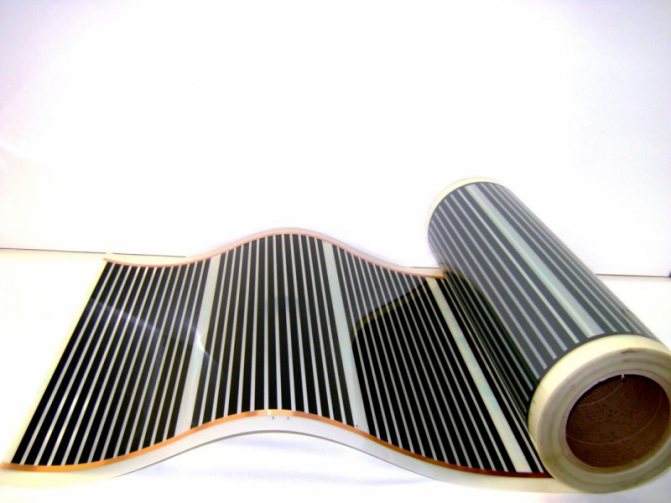

Heating after the first start occurs after 2 - 3 hours
Film infrared warm floors are attracting more and more attention of consumers. In the polymer layer of the film, an electrode grid is soldered, which, under the influence of an electric current, emits heat rays in the infrared range.
Related article: Differences between plastic windows
Many people are interested in how quickly the flooring heats up from the IR film. This question cannot be answered unequivocally. It all depends on the coverage area, the technical parameters of the IR film, the method of laying the connection diagram to the electrical network. But one can say that where the floor was heated under the IR coating, the time of the first heating was 2 - 3 hours.
Due to their design features, IR coatings can be easily and quickly installed under any floor covering, except for ceramic tiles. An exception is the infrared heating device under the tiles. For more information on connecting and heating the floor, see this video:
An example of an infrared heating device for laminate parquet
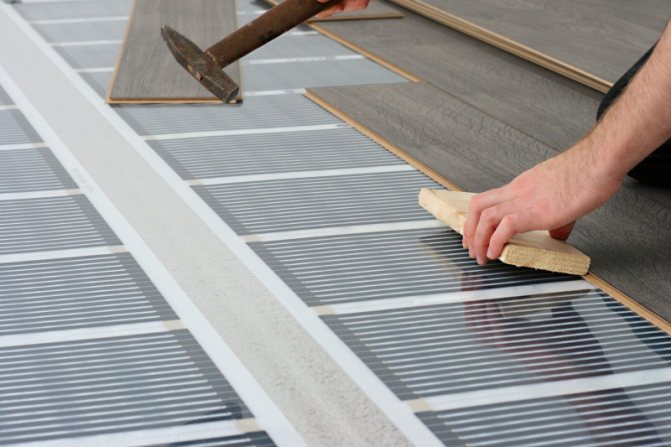

The device of a warm floor of this type consists of several stages:
- A vapor barrier made of a thick polyethylene film is laid on the finished base of the floor.
- Then, thermal insulation is laid from polyurethane plates, polystyrene foam or other similar material.
- In some cases, the thermal insulation is covered with a layer of bituminous coating mastic.
- A foil substrate is laid on top of a layer of mastic or thermal insulation, which is laid with a reflective surface directed upwards.
- Rolls of IR film are rolled over the surface of the substrate. Fragments of the IR coating are connected with contact clips.
- Install a thermal sensor.
- Connect the IR heating to the mains through a control unit equipped with a display.
- Tests are carried out. The identified defects are eliminated. The test is repeated.
- A soft substrate is spread on top of the IR coating.
- Laminate parquet is laid on the substrate. You can watch a detailed installation of the film on the floor in this video:
Let us reflect in the table examples of the need for time until the underfloor heating systems are fully heated when they are first turned on:
| № | Underfloor heating system | Time to full heating |
| 1 | Water heated floors | 12 hours or more |
| 2 | Cable heating | 6 - 8 hours |
| 3 | IR film coatings | 2 - 3 hours |
Yulia Dymova, director of the Est-a-Tet resale real estate sales office, answers:
The living quarters must be landscaped, and appropriate regulations must be established for carrying out these works. Self-replacement of the heating system is impossible - it is carried out only with the consent of the management company, which will notify all residents of the house. In the cold season, the heating shutdown period should not exceed three hours.
How to choose heating radiators?
What is the best time of the year for renovations?
Heating system pressure testing
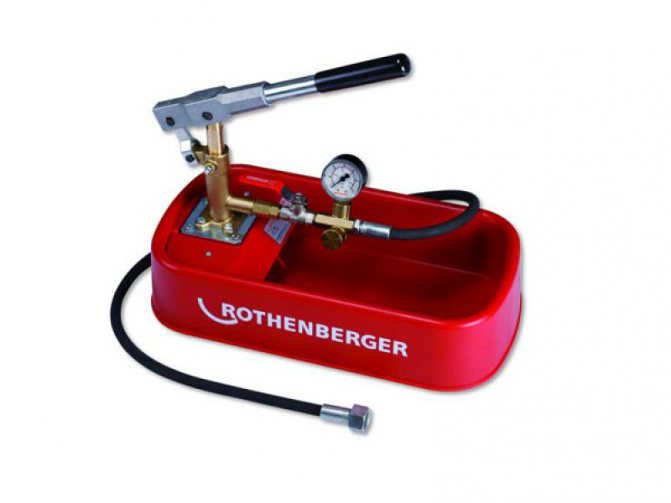

Manual pressure pump
In some cases, crimping is neglected. However, it is important when starting up a closed heating system. This is especially true when the work is done in winter. The essence of this method is to check the state of the elements of the system by creating excess pressure inside it.
With the help of a special hydraulic pump, a pressure is injected inside the line, which exceeds the standard by 1.25 times. As a result, components containing hidden defects fail. They can be detected visually - the appearance of leaks (hydraulic pressure test) or air bleeding. To start the heating system in winter, such a check must be carried out according to the following scheme:
- The choice of method is hydraulic, air. It is recommended to choose the first one, as it will allow you to more accurately determine the "weak" points in the line;
- Connecting the pump to the circuit;
- Overpressure creation. At this stage, the maximum possible parameters must be strictly observed. If they exceed the permissible by 1.5 times, it is possible that even previously serviceable components fail;
- Visual control of the state of heating and drainage of liquid.
Before starting heating in an apartment building, representatives of the management company must warn tenants about pressure testing. At this time, you need to be at home and monitor the condition of the battery and pipes. If defects are found, immediately contact the management company to eliminate them.
The standard heating system start-up instructions do not include maximum pressure values for pressure testing. If you perform this procedure yourself, there is a high probability of error. Therefore, it is for its implementation that it is best to invite a specialist.

